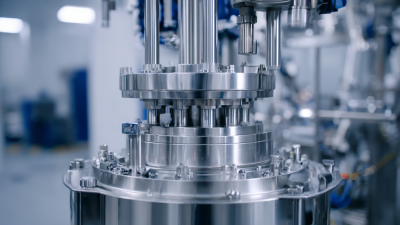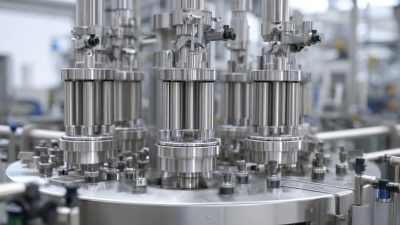When it comes to dairy production, getting that perfect texture and consistency in products like milk isn’t just about good ingredients — it often requires some pretty advanced tech and equipment. One thing that can really make a difference is a Milk Homogenizer. These machines break down fat globules into smaller sizes and spread them out evenly, which not only keeps the milk stable but also makes it taste better and feel creamier when you drink it.

Here at CAS PETER (HANGZHOU) NANOTECHNOLOGY CO., LTD, we’re all about high-pressure homogenizers and microfluidizers that cater to the diverse needs of the dairy world. Our innovative nanotech solutions give producers the tools to fine-tune their processes, helping them craft higher-quality dairy products that folks really love. In this article, I’ll share some practical tips on how you can make the most out of a Milk Homogenizer — from the benefits it offers to techniques and the top equipment brands like CAS PETER that are leading the way.
Milk homogenizers are pretty much essential when it comes to making dairy production run smoothly. Basically, they break down those fat globules so they’re all the same size, which helps stop cream from separating out and gives you a consistent, smooth texture in your milk and dairy products. This isn’t just about better quality—it also helps your milk last longer on the shelf, which makes it more appealing to shoppers. When you use homogenizers correctly, you can really cut down on waste and make your entire dairy operation a lot more efficient.
If you're looking to get the most out of your homogenizer, here are a few tips:
Homogenization is such a vital step in dairy production — honestly, it can really make a difference in both the quality and how long milk stays good. Basically, it breaks down fat globules into tiny, even-sized pieces, which stops the cream from separating out and gives the milk a smooth, consistent texture and flavor. For retailers, this stability is a big deal because customers love products that look appealing. Nobody wants to see floating cream or have that weird separation, right? So, homogenization helps keep the milk looking fresh and inviting.

And there's more — it actually helps the milk last longer too. When the fat tiny particles are broken down, they create an environment that’s less friendly for bacteria, which means spoilage happens more slowly. Combine that with pasteurization, and you’ve got dairy that stays fresher for a longer time. That’s a win-win: less waste, happier customers. Plus, with a longer shelf life, producers can ship their milk further without worrying about it losing quality. All in all, homogenization isn’t just a fancy process — it’s pretty much essential for any modern dairy operation trying to keep up with demand and quality standards.
When you're into dairy production, a milk homogenizer really becomes your best buddy. It’s the kind of tool that can seriously boost the quality and consistency of your milk products. Honestly, getting a handle on how it works—like knowing about parts such as the homogenizing valve, the pressure pump, and the shear force mechanism—can make a big difference in how well it performs and how long it lasts. These components are pretty much the heart of the process, breaking down fat globules and making sure everything is evenly mixed. And let’s be honest, taking good care of them is what keeps things running smoothly and your product top-notch.
To keep your milk homogenizer working like a champ, regular maintenance is the way to go. Simple stuff like keeping an eye on pressure levels or giving the homogenizing valve a quick check now and then can save you from surprises—nobody likes unexpected downtime, right? Also, making sure the shear forces are dialed in just right will help give your dairy products that perfect, smooth mouthfeel your customers love.
Oh, and don’t forget—investing in good quality parts really pays off. Using sturdy materials for seals, gaskets, and other components means fewer breakages or replacements over time. If you follow these little tips, not only will your production stay on point, but your dairy goodies will also stand out even more for their quality and consistency.
| Component | Function | Impact on Performance | Maintenance Frequency |
|---|---|---|---|
| Homogenizing Valve | Reduces fat globule size | Improves product stability and texture | Every 3 months |
| Pump | Transfers milk at high pressure | Ensures uniformity in product | Monthly |
| Silencer | Reduces operational noise | Improves workplace environment | Annually |
| Temperature Control | Maintains optimal processing temperature | Prevents product spoilage | Monthly |
| Energy Recovery System | Recovers energy from the homogenizing process | Reduces energy costs | Annually |
Honestly, putting money into homogenization tech can really boost how efficiently dairy is produced and improve the quality of the milk and other dairy goods. When you add a milk homogenizer into the mix, it kinda simplifies the whole process by making sure the fat spreads out evenly. That results in creamier textures and helps dairy products stay fresh longer. Plus, it means you don’t need as many stabilizers or emulsifiers, so the end product feels more natural—almost like straight from the farm. Of course, when you’re figuring out whether it’s worth the cost, you’ve gotta look at not just the upfront investment but also the long-term savings—like less waste and fewer ingredients needed over time.
On top of that, the increased efficiency from using a milk homogenizer can help cut down energy bills and reduce the amount of labor needed. Automating this step means a dairy operation can crank up production without sacrificing quality. When you compare the costs to the benefits, things like better-looking products, a chance to sell more, and lower overhead expenses make a pretty strong case for jumping on board with this tech. Overall, investing in homogenization really seems like a smart move for dairy producers who want to stay competitive and keep their production running smoothly.
In the dairy world, sticking to industry standards and following regulations isn’t just a formality—it's really key for keeping things safe and top quality. Using a milk homogenizer is a big part of that. It helps you get a consistent, smooth product that ticks all the boxes set by health authorities. Basically, it works by breaking down those fat molecules, so they don’t separate out in the milk. Not only does that make the milk feel nicer to drink, but it also keeps the final product stable over time. That kind of consistency is super important if you want to meet all the strict specs for dairy products and make sure they’re safe for people to enjoy.

Plus, having a good homogenizer makes it easier for dairy producers to stay on top of various quality rules. Many regulations require dairy products to have specific fat levels and nutrient distribution, among other things. When you fine-tune these elements through proper homogenization, you're less likely to run into costly recalls or legal headaches, and you help build a reputation for quality. All in all, investing in a reliable milk homogenizer isn’t just about making production smoother—it also helps you stay within industry standards. That’s a win for producers and consumers alike.
Milk homogenizers are pretty much essential in the dairy world—they help make your products more consistent and last longer on the shelf. If you're trying to keep yours running smoothly, it's a good idea to follow some best practices. Not only will these tips keep things ticking efficiently, but they'll also help extend how long your machine stays in good shape. I Read somewhere that, according to the Dairy Equipment Manufacturers Association (or DEMA), when you take good care of your homogenizer, you can actually boost your production efficiency by up to 20%. That's pretty significant!
So, what's the scoop on maintenance? First off, regular cleaning and inspections are key. Residue buildup can mess with performance and even cause your products to spoil faster. I'd suggest setting aside time every day to clean and do a more thorough check weekly for any signs of wear or damage in those important parts. Also, don’t forget about lubrication—keeping those moving parts well-oiled according to the manufacturer’s instructions can really help reduce friction and prevent unexpected breakdowns.
While you’re at it, keep an eye on the pressure and temperature during operation. Usually, the optimal pressure is somewhere between 1,500 and 2,500 psi, but it really depends on what texture you’re aiming for. Using pressure gauges and temperature sensors can make monitoring a lot easier. Lastly, it’s super helpful to train your staff on how to operate the homogenizer correctly—this way, human errors are minimized, and your production stays efficient while your dairy products stay top-notch.
: Milk homogenizers break down fat globules to a uniform size, preventing cream separation and ensuring a consistent texture in milk products.
By preventing cream separation, homogenizers enhance the consistency and stability of milk, which in turn extends its shelf life and makes it more appealing to consumers.
Regular maintenance, closely monitoring pressure settings, and experimenting with different homogenization processes are key tips for optimizing the use of homogenizers.
Scheduled maintenance prevents unexpected breakdowns and ensures that the homogenizer operates at peak efficiency.
Homogenizers produce a consistent product that meets health regulations, optimizing physical and chemical properties required for dairy products.
Using a reliable homogenizer can help avoid costly recalls and legal issues, while maintaining a reputation for high-quality products.
Yes, adjusting the pressure according to the specific type of milk being processed can lead to better homogenization results.
Proper utilization of homogenizers can significantly minimize waste and enhance overall productivity in dairy operations.
Effective homogenization ensures that dairy products meet the required specifications for fat content and nutrient distribution, which is crucial for quality control.
Investing in a reliable homogenizer can streamline production processes and enhance compliance with industry standards, benefiting both producers and consumers.
Making dairy production more efficient and improving product quality isn't just a buzzword—it's essential, and a Milk Homogenizer really makes a difference here. Once you get the hang of how homogenization works and its benefits, it becomes clear how much it can boost milk quality and even help it stay fresh longer. Investing in a good Milk Homogenizer isn’t just about saving costs—it’s also about meeting industry standards and regulations, which honestly, makes consumers trust your product even more.
That said, to really get the most out of these machines, proper maintenance and operation are key. Companies like CAS PETER (HANGZHOU) NANOTECHNOLOGY CO., LTD are pros at high-pressure homogenization, offering cutting-edge solutions that can be customized to fit various needs in the dairy world. By taking advantage of these innovative techs, dairy producers can hit those top-notch quality standards while boosting overall output and efficiency—kind of a win-win, right?







